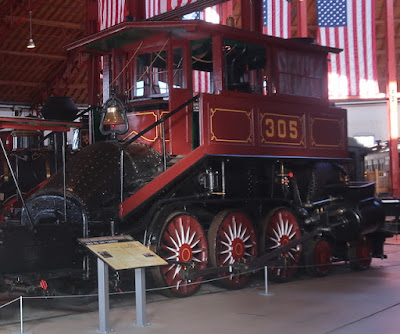 |
| B&O Railroad Museum Roundhouse |
The first exhibit (after getting past the gift shop/ticket office) is a commemoration of the founding of the railroad, with a talking bust of Charles Carroll. The animatronic bust freaked out my youngest child. It looks a lot like a stone bust.
 |
| Charles Carroll explains the start of the railroad |
 |
| Keystone of the railroad |
Nearby is the remains of the Stourbridge Lion, an early engine used on the rail line.
 |
| Model of the Stourbridge Lion |
 |
| The belly of the beast |
The Roundhouse has a spacious central room with many historic locomotives and displays.
 |
| First view of the roundhouse area |
 |
| Old time engines |
 |
| Newer (but not new) engines |
The outer walls have a variety of displays. We saw tools of the trade used by locomotive engineers.
 |
| Useful items for rail workers |
Some of the engines have ramps that let visitors see the interiors. Clinchfield No. 1 was built in 1882 and served on various lines until 1979. That's a long life for a steam locomotive!
 |
| Clinchfield No. 1 |
 |
| A volunteer engineer |
 |
| Why isn't anything labeled? |
 |
| Trying her hand at running the engine |
The next "walk through" car was a mail car. To keep from stopping at every town, the mail car was equipped with a hook that would grab a hanging bag of mail. They didn't say how mail was delivered. Maybe they just chucked out the local mail as they went by?
 |
| Mail hook |
 |
| Picture of mail car with hook in action |
 |
| Closeup of the hook |
 |
| The mail sorting room |
The next car had displays describing segregation on the rails in the past. The car has a divider in the passenger car.
 |
| White only section in back |
We saw a luggage cart that really is a cart!
 |
| Not traveling light |
One section of the roundhouse is dedicated to the first locomotives in America. The area includes transportation similar to the railroads.
 |
| Stagecoach |
 |
| Conestoga Wagon |
One of the earliest trains was a one-horse powered passenger vehicle. The horse-drawn rail carriage was used because the British locomotives were too big for the sharp turns and steep grades on the B&O line. The trip from Baltimore to Ellicott's Mills (now Ellicott City) took an hour and a half for the horse-drawn train. It's displayed next to one of the earliest mechanical engines.
 |
| Maybe the horse's name is John Henry? |
 |
| Riding the horse-powered train |
Another early passenger train looked like it had good views but we could not figure out how to get into the upper seats. Also, looking at the picture now, I wonder how the passengers avoided the smoke from the engine's stack.
 |
| Stagecoach, now on rails! |
Lots of other engines and cars are all around the floor.
 |
| More early engines |
Engine 305 impressed me with the engineer's cabin on top of the boiler.
 |
| Engine 305 |
 |
| Closeup of the high-riding cabin |
 |
| A classic style engine |
Another display area has some trains from the American Civil War. This passenger car carried forty to fifty people. The quick movement of troops and supplies made some very substantial changes in how war was conducted.
 |
| No. 21 passenger car |
The B&O made iron box cars as an experiment in more durable freight cars. Wooden cars were cheaper but wore out more quick. The iron cars had the additional advantages of being fireproof and, in some cases, bulletproof.
 |
| Iron boxcar |
Another exhibit explains the switch to synchronized times so that schedules could be kept and accidents avoided. Nowadays it seems incredible that different states and towns had their own times.
The engineers on the trains needed synchronized timepieces as well, thus this display of pocket watches. The company required them to buy their own watches, which were submitted to the Time Service Department for inspection. Accuracy and durability were the most important qualities.
 |
| Wall clocks from train stations |
The engineers on the trains needed synchronized timepieces as well, thus this display of pocket watches. The company required them to buy their own watches, which were submitted to the Time Service Department for inspection. Accuracy and durability were the most important qualities.
 |
| Keeping accurate time just got personal |
More of the museum in the next post!



No comments:
Post a Comment